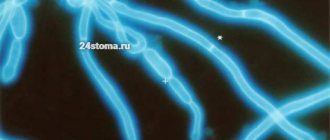Adenosis (glandular mastopathy) is a disease in which an increase in the glandular component occurs and a change in the qualitative composition of the connective tissue of the mammary glands.
The predominant element of the stroma is collagen fibers, while the number of elastic fibers sharply decreases. In the mammary glands with adenosis, processes of both proliferation and regression are observed. This determines the complexity of the morphological changes occurring. Currently, there is a steady increase in glandular mastopathy (mammary adenosis) throughout the world. The frequency of this pathology in women of childbearing age ranges from 30 to 70%, and in patients suffering from gynecological pathology, it reaches 100%. At the same time, the greatest risk of adenosis is observed in those women who have gynecological diseases of a hyperplastic nature - uterine fibroids, endometrial hyperplasia, endometriosis and others.
Risk factors for mammary adenosis
In addition to the above risk factors for mammary adenosis, the following conditions are of great etiopathogenetic importance:
· no history of childbirth or pregnancy;
· late first pregnancy (35 years and older);
· induced abortions, especially at 14 weeks and later (up to 22 weeks);
· Lack of lactation or breastfeeding for no more than 2-3 months.
Effective treatment of mammary adenosis >>>
Long-term breastfeeding (more than a year) is also dangerous if the baby is not given anything other than breast milk, i.e. There are no complementary foods in his diet. In such conditions, increased lactation is observed to meet the growing needs of the child. Therefore, it may fail with the development of uncontrolled cell division of a benign nature.
Types of mastopathy
There are diffuse and nodular mastopathy. The diffuse form is characterized by uniform growth of epithelium and connective tissue in the mammary gland. With nodular mastopathy, one or more compacted nodules with a clear boundary are found - this is the result of local proliferation of fibrous tissue and dilation of the ducts. According to research, nodular mastopathy, being a local form of the disease, is easier, and moreover, it has a more favorable prognosis. With mastopathy, an increase in the number and size of epithelial cells is detected at the microscopic level - this phenomenon is called hyperplasia. There are lobular (proliferation of the lobules of the mammary gland) and ductal (proliferation of the epithelium of the ducts) hyperplasia. If hyperplasia also changes the shape of the cells, it is regarded as atypical and more likely to degenerate into cancer than others.
Adenosis of the mammary glands is a form of mastopathy with a predominance of hyperplasia of the glandular epithelium of the lobules. If hyperplasia of the epithelium of the milk ducts predominates, then dead epithelial cells in large numbers clog the lumen of the ducts, causing them to expand. This phenomenon is called mammary duct ectasia.
Hyperplasia, adenosis and ectasia of the mammary glands have typical symptoms of mastopathy and are often used as its synonyms.
Treatment of adenosis
In most cases, adenosis is treated with conservative methods. It is practiced to take vitamins, minerals, sedatives, homeopathic medicines and herbal remedies. Lifestyle changes are also of great importance: women are recommended to exercise physical activity, healthy eating and a calm atmosphere. Sometimes hormonal correction is required. Surgery is performed only in exceptional cases, if tumors quickly increase in size or number, and conservative therapy does not produce results. It is believed that adenosis of the mammary glands does not increase a woman’s chances of getting cancer, but only if it does not progress. Therefore, it is very important to consult a doctor at the first sign of a problem and begin treatment.
26
What is mastopathy?
Mastopathy is a benign process in which the correct relationship between the cells of the glandular epithelium and connective tissue is disrupted in the breast tissue. Minor changes are also found at the level of cell structure. According to statistics, women with benign mammary dysplasia develop breast cancer 3–4 times more often than healthy women. If the process is accompanied by the proliferation of epithelial cells with the formation of nodules, then the risk of developing cancer increases by 30–40 times. Up to 60–90% of women of reproductive age have certain signs of mastopathy. The main reason for the development of this disease is hormonal imbalance. With benign dysplasia, there is an excess of estrogen against the background of progesterone deficiency. This imbalance is caused by:
- chronic gynecological diseases;
- obesity;
- some general somatic diseases (diabetes mellitus, hypothyroidism, arterial hypertension, etc.);
- certain methods of contraception;
- menstrual irregularities;
- constant stress, etc.
Book a consultation 24 hours a day
+7+7+78
Pseudoangiomatous stromal hyperplasia
Pathology is rare. On palpation, a painless formation with skin swelling of the “lemon peel” type is determined.
For additional examination, the entire range of instrumental diagnostics is used (mammography, ultrasound, MRI).
If this pathology is detected, treatment is surgical. It is permissible to perform vacuum-aspiration resection, and in some cases, sectoral resection of the mammary gland.
The prognosis is favorable.
Leaf-shaped tumor
Leaf-shaped tumor is a rare group of tumors, with an incidence of about 0.3% of all breast neoplasms.
The average age of women suffering from this pathology varies from 45 to 49 years.
In 80% of the tumor is benign. About 5% is the malignant form. The remaining cases are of the borderline type.
The clinical course is divided into 2 periods: a period of stabilization and a period of intensive growth.
For the purpose of invasive diagnosis, preference is given to core biopsy.
Treatment in most cases is surgical. For small tumors, sectoral resection of the mammary gland is performed. Tumor enucleation is unacceptable due to the almost 100% risk of tumor recurrence.
For large malignant tumors, mastectomy without lymphadenectomy is performed, followed by dynamic monitoring.
The prognosis is favorable.
Rumyantseva, md.
Breast cancer is the most dangerous of all breast diseases. However, benign breast diseases are much more common.
Benign diseases can increase the risk of developing breast cancer, but in themselves they do not threaten a woman’s health and in the vast majority of cases do not require treatment.
At the same time, it is extremely important to correctly diagnose the condition that has developed in a woman, so as not to miss breast cancer in the early stages. Since examination and palpation, as well as mammography, often cannot tell for sure whether the disease is benign or requires closer attention, in many cases a biopsy is recommended when changes in the breast tissue are detected.
Benign diseases are divided into the following groups:
Non-proliferative diseases:
Does not increase the risk of developing breast cancer
- Fibrosis and cysts (fibrocystic mastopathy),
- Moderate hyperplasia,
- Adenosis (non-sclerosing),
- Benign epithelioma,
- Single papillomas,
- Fat necrosis,
- Dilation of the mammary ducts,
- Periductal fibrosis,
- Squamous or apocrine metaplasia,
- Calcifications,
- Other benign tumors (lipoma, hamartroma, hemangioma, neurofibroma, etc.),
- Mastitis (mastitis is not a tumor or formation in the mammary gland, but it belongs to this group because it does not increase the likelihood of developing breast cancer).
Proliferative diseases without atypia:
In these diseases, there is increased cell growth in the ducts or lobes of the mammary gland; these diseases increase the risk of developing breast cancer by 1.5-2 times
- Ductal hyperplasia (without atypia),
- Fibroadenoma,
- Sclerosing adenosis,
- Multiple papillomas (papillomatosis),
- Radial scar.
Proliferative diseases with atypia:
In these diseases, increased cell growth is observed in the ducts or lobes of the mammary gland, with some of these cells acquiring signs of atypia; these diseases increase the risk of developing breast cancer by 4-5 times
- Ductal hyperplasia with atypia,
- Lobular hyperplasia with atypia,
- Carcinoma in situ: growth of atypical cells that does not extend beyond the lobe/duct, i.e. does not grow through the wall, often also called “precancer”.
The causes of the vast majority of benign breast diseases are unknown (except mastitis). As with breast cancer, there are factors that increase the likelihood of detecting a particular disease, but it is not yet possible to prevent these diseases.
Let's look in a little more detail at the most common benign breast diseases:
Breast fibrosis and simple cysts
Breast fibrosis in Russia is often called fibrocystic mastopathy. This is the most common cause of lumps or discomfort in the mammary gland. With this condition, a woman may experience:
- pain in the breast area, intensifying before menstruation,
- lumps in breast tissue,
- discharge from the nipple.
The disease is most common in women of reproductive age. Fibrosis and cysts can be found both in one mammary gland and on both sides. A presumptive diagnosis can be made during examination and interview, because It is this disease that is characterized by increased pain before the onset of menstruation. Mammography and ultrasound also help detect changes in breast tissue. In some cases, a biopsy of the contents of the cysts is required to exclude a malignant disease and make a final diagnosis. In the vast majority of cases, treatment is not required.
There are currently no drugs that can cure breast fibrosis.
Treatment is required if a woman experiences pain in the breast area and consists of wearing supportive underwear, applying warm compresses, and taking painkillers if necessary. Many women feel relief if they eliminate tea, coffee and chocolate. If there is significant pain before menstruation, limiting salt intake may be recommended, as well as prescribing diuretics (diuretics) in some cases. It is also possible to prescribe hormonal drugs (in particular, contraceptives) in severe cases.
Hyperplasia (ductal or lobular)
Hyperplasia is the excess growth of cells lining the ducts or lobules of the mammary gland. Hyperplasia can be without atypia or with atypia, depending on the structure of the cells, determined under a microscope during a biopsy of breast tissue. Depending on whether the hyperplasia is ductal or lobular and the presence of atypia, hyperplasia may or may not increase the risk of developing breast cancer. Hyperplasia usually does not cause any symptoms. This disease can be suspected by mammography and confirmed by biopsy.
There is no treatment, but women with atypical hyperplasia need more careful monitoring by a mammologist, because they have a significantly increased risk of developing breast cancer.
Carcinoma in situ
Carcinoma in situ is a disease in which atypical cells (cells whose structure corresponds to breast cancer) are detected within one lobe of the breast, but do not invade the wall and surrounding tissues. Carcinoma in situ does not necessarily develop into breast cancer, but this diagnosis significantly increases the risk of its development, and therefore such patients require special attention and more frequent preventive examinations. Caricnoma in situ often does not cause any discomfort in a woman; it most often cannot be felt during examination, nor can it be seen on a mammogram or ultrasound. In this regard, it is discovered accidentally in many patients during a biopsy performed for another reason (cysts and other breast formations). There is no drug treatment.
In accordance with international recommendations, caricnoma in situ does not require treatment, but requires dynamic monitoring of the patient.
However, it is necessary to take into account the presence of other risk factors in this patient (complicated family history, mutations in the BRCA 1 and 2 genes). When several factors combine, removal of the affected area may be recommended. Some patients with carcinoma in situ prefer prophylactic removal of both breasts followed by implants.
Breast adenosis
Adenosis is a disease in which the lobules of the mammary gland enlarge due to an increase in the amount of glandular tissue. Adenosis is most often detected by breast tissue biopsy in women with fibrosis and cysts. In some cases, an increase in several adjacent lobules can be felt by a woman or a doctor as a lump in the mammary gland, in other cases the disease does not manifest itself. If a lump is detected without a biopsy, it is impossible to say with certainty whether the patient has adenosis or breast cancer. With adenosis, the formation of dense calcifications, which are visible on mammography, is also possible. In such cases, a biopsy is also necessary to make a final diagnosis, because Calcifications can also form in breast cancer. Ultrasound may also suspect adenosis, but not make a definitive diagnosis.
Treatment for adenosis is not required. Adenosis can be of two types: non-sclerosing (does not increase the risk of breast cancer) and sclerosing (increases the risk of breast cancer).
Fibroadenoma of the breast
Fibroadenomas are benign tumors consisting of glandular and connective tissue of the mammary gland. They are most often detected in young women (under 40 years of age), but can sometimes be diagnosed at a later age. In most cases, fibroadenomas do not cause discomfort, but can be felt by a woman or doctor as round, mobile, painless lumps in the breast tissue. The final diagnosis is made by biopsy. If a fibroadenoma does not grow, does not change in shape, does not deform the mammary gland and does not cause discomfort, it does not need to be removed (if, according to the biopsy, there is an accurate diagnosis that it is a fibroadenoma). If growth of nodes or deformation of the mammary gland is observed, it is recommended to remove the node/nodes. After removal, new nodes may form. This does not mean that the removed node has “returned”, it is the formation of a new node in the same place or nearby. Fibroadenomas can undergo independent regression (most often during menopause).
Intraductal papillomas
Intraductal papillomas are benign formations growing inside the ducts of the mammary gland. Papillomas can lead to the appearance of discharge (including bloody) from the nipple. Large papillomas located near the nipple can sometimes be felt during examination; they can cause discomfort to the patient. Separately, papillomatosis is distinguished, in which many small-sized papillomas are formed in the ducts. The diagnosis is made on the basis of a ductogram (x-ray of the breast with the introduction of a contrast agent into the ducts). In the presence of large papillomas, a biopsy may be performed.
Treatment is removal of papillomas and the affected area of the mammary duct.
Mastitis
Mastitis is an inflammatory disease of the breast. Mastitis develops as a result of a woman’s body’s reaction to an infection invading the mammary gland. Mastitis often affects women during lactation. In most cases, mastitis is diagnosed based on a survey and examination of the woman. Mastitis is quite severe:
- edema,
- redness,
- hyperemia,
- soreness of the affected area,
- discharge from the nipple may appear,
- development of general symptoms of intoxication: headache, elevated body temperature.
Treatment is carried out with antibacterial drugs. When an abscess forms (a complication of mastitis), you should first puncture and empty the abscess, and then a course of antibiotic therapy. It is important to remember that there is a rare type of breast cancer that can cause similar symptoms. In this regard, if taking antibiotics does not lead to recovery within a week, a more thorough examination should be carried out.
To summarize:
- Benign tumors are much more common than breast cancer. If you felt the lump yourself/the doctor at the appointment discovered changes in the breast tissue/changes were detected during mammography, it is most likely that this is a benign process.
- Most benign breast processes do not manifest themselves in any way.
- The final diagnosis in most cases is made after a biopsy.
- In most cases, treatment is not required if the patient has no complaints.
- Some benign diseases increase the risk of developing breast cancer and therefore require more detailed monitoring (hyperplasia with or without atypia; fibroadenoma, sclerosing adenosis, papillomatosis, carcinoma in situ).
Read more about breast cancer and about preventive examinations for early detection of breast cancer by following the links:
- Mammary cancer
- Preventive screenings for early detection of breast cancer
Sources:
- https://www.cancer.org/acs/groups/cid/documents/webcontent/003178-pdf.pdf
- https://www.cancer.org/cancer/breastcancer/moreinformation/breastcancerearlydetection/breast-cancer-early-detection-acs-recs
- American Cancer Society. Breast Cancer Facts and Figures 2013-2014. Atlanta, Ga: American Cancer Society; 2013.
- American College of Radiology. BI-RADS ATLAS – Mammography. Reporting System, 2013. American College of Radiology - Radiology Society of North America. Patient Safety: Radiation Exposure in X-ray and CT Examinations.
- Rupture of silicone-gel breast implants: causes, sequelae, and diagnosis. 1997;350:1531-1537.
- Bruening W, Uhl S, Fontanarosa J, Reston J, Treadwell J, Schoelles K. Noninvasive Diagnostic Tests for Breast Abnormalities: Update of a 2006 Review. Rockville (MD): Agency for Healthcare Research and Quality (US); 2012 Feb.
- Caldarella C, Treglia G, Giordano A. Diagnostic performance of dedicated positron emission mammography using fluorine-18-fluorodeoxyglucose in women with suspicious breast lesions: a meta-analysis. Clin Breast Cancer. 2014 Aug;14(4):241-8. Epub 2013 Dec 27.
- Freeman MT. Imaging: New techniques. In: Harris JR, Lippman ME, Morrow M, Osborne CK, eds. Diseases of the Breast. 4th ed. Philadelphia, Pa: Lippincott Williams & Wilkins; 2010:171-192.
- Helvie MA. Imaging analysis: Mammography. In: Harris JR, Lippman ME, Morrow M, Osborne CK, eds. Diseases of the Breast. 4th ed. Philadelphia, Pa: Lippincott Williams & Wilkins; 2010:116-130.
- Hortobagyi GN, Esserman L, Buchholz TA. Neoplasms of the Breast. In: Hong WK, Bast RC, Hait WN, et al, eds. Cancer Medicine. 8th ed. Shelton CT: People's Medical Publishing House – USA/BC Decker; 2010:1393-1459.
- Hubbard RA, Kerlikowske K, Flowers CI, et al. Cumulative probability of false-positive recall or biopsy recommendation after 10 years of screening mammography: a cohort study. Ann Intern Med 2011;155:481-492.
- Osteen RT. Breast cancer. In: Lenhard RE, Osteen RT, Gansler T, eds. Clinical Oncology. Atlanta, Ga: American Cancer Society; 2001:251-268.
- Pisano ED, Gatsonis C, Hendrick E, et al. Diagnostic performance of digital versus film mammography for breast-cancer screening. N Engl J Med. 2005;353:1773-1783.
- Puliti D, Duffey SW, Miccinesi G, et al. Overdiagnosis in mammographic screening for breast cancer in Europe: a literature review. J Med Screen 2012;19:Suppl 1:42-56.
- Rosenberg RD, Hunt WC, Williamson MR, et al. Effects of age, breast density, ethnicity, and estrogen replacement therapy on screening mammographic sensitivity and cancer stage at diagnosis: Review of 183,134 screening mammograms in Albuquerque, New Mexico. Radiology 1998; 209:511–518.
- Rosenberg RD, Yankaskas BC, Abraham LA, et al. Performance benchmarks for screening mammography. Radiology. 2006 Oct;241(1):55-66.
- Saslow D, Boetes C, Burke W, et al for the American Cancer Society Breast Cancer Advisory Group. American Cancer Society guidelines for breast screening with MRI as an adjunct to mammography. CA Cancer J Clin. 2007;57:75-79.
- Skaane P, Bandos AI, Gullien R, et al. Comparison of digital mammography alone and digital mammography plus tomosynthesis in a population-based screening program. Radiology. 2013 Apr;267(1):47-56.
- Smith RA, D'Orsi C, Newell MS. Screening for breast cancer. In: Harris JR, Lippman ME, Morrow M, Osborne CK, eds. Diseases of the Breast. 4th ed. Philadelphia, Pa: Lippincott Williams & Wilkins; 2010:87-115.
- Tabar L, Vitak B, Tony HH, et al. Beyond randomized controlled trials: organized mammographic screening substantially reduces breast carcinoma mortality. Cancer. 2001;91:1724-1731.
- Weigert JM, Bertrand ML, Lanzkowsky L, Stern LH, Kieper DA. Results of a multicenter patient registry to determine the clinical impact of breast-specific gamma imaging, a molecular breast imaging technique. AJR Am J Roentgenol. 2012
- Bleicher RJ. Management of the palpable breast mass. In: Harris JR, Lippman ME, Morrow M, Osborne CK, eds. Diseases of the Breast. 4th ed. Philadelphia, Pa: Lippincott Williams & Wilkins; 2010:32-41.
- Calhoun KE, Lawton TJ, Kim JN, Lehman CD, Anderson BO. Phyllodes tumors. In: Harris JR, Lippman ME, Morrow M, Osborne CK, eds. Diseases of the Breast. 4th ed. Philadelphia, Pa: Lippincott Williams & Wilkins; 2010:781-792.
- Guray M, Sahin AA. Benign breast diseases: Classification, diagnosis, and management. 2006;11;435-449.
- Hartmann LC, Sellers TA, Frost MH, et al. Benign breast disease and the risk of breast cancer. N Engl J Med. 2005;353:229-237.
- Kilbride KE, Newman LA. Lobular Carcinoma In Situ: Clinical Management. In: Harris JR, Lippman ME, Morrow M, Osborne CK, eds. Diseases of the Breast. 4th ed. Philadelphia, Pa: Lippincott Williams & Wilkins; 2010:341-347.
- Lewis JT, Hartmann LC, Vierkant RA, et al. An analysis of breast cancer risk in women with single, multiple, and atypical papilloma. Am J Surg Pathol. 2006;30:665-672.
- Santen RJ, Mansel R. Benign breast disorders. N Engl J Med. 2005;353:275-285.
- Schnitt SJ, Collins LC. Pathology of breast disorders. In: Harris JR, Lippman ME, Morrow M, Osborne CK, eds. Diseases of the Breast. 4th ed. Philadelphia, Pa: Lippincott Williams & Wilkins; 2010:69-85.
- Scott BG, Silberfein EJ, Pham HQ, et al. Rate of malignancies in breast abscesses and argument for ultrasound drainage. Am J Surg. 2006;192:869-872.
- Rosenberg RD, Hunt WC, Williamson MR, et al.: Effects of age, breast density, ethnicity, and estrogen replacement therapy on screening mammographic sensitivity and cancer stage at diagnosis: review of 183,134 screening mammograms in Albuquerque, New Mexico. Radiology 209(2):511-8, 1998.
- Kerlikowske K, Grady D, Barclay J, et al.: Likelihood ratios for modern screening mammography. Risk of breast cancer based on age and mammographic interpretation. JAMA 276(1):39-43, 1996.
- Zahl PH, Strand BH, Maehlen J: Incidence of breast cancer in Norway and Sweden during introduction of nationwide screening: prospective cohort study. BMJ 328(7445):921-4, 2004.
- Nelson HD, Tyne K, Naik A, et al.: Screening for breast cancer: an update for the US Preventive Services Task Force. Ann Intern Med 151(10):727-37, W237-42, 2009.
- Orel SG, Schnall MD, LiVolsi VA, et al. Suspicious breast lesions: MR imaging with radiologic-pathologic correlation.1994;190:485-493.
- Devolli-Disha E, Manxhuka-Kërliu S, Ymeri H, Kutllovci A. Bosn J Basic Med Sci. 2009 May;9(2):131-6. Comparative accuracy of mammography and ultrasound in women with breast symptoms according to age and breast density.
- Zhu H, Lei X, Feng J, Wang Y. Oral contraceptive use and risk of breast cancer: a meta-analysis of prospective cohort studies. Eur J Contracept Reprod Health Care. 2012 Dec;17(6):402-14. doi: 10.3109/13625187.2012.715357. Epub 2012 Oct 14.
Similar
Facebook comments
Symptoms of mastopathy
In some cases, patients live for years without even realizing they have mastopathy. Unpleasant symptoms are observed only in 38–50% of cases; they depend on the form of the disease and the phase of the menstrual cycle.
The main signs of diffuse mastopathy:
- pain in the mammary glands (mastalgia),
- swelling and enlargement of the mammary glands (mastodynia),
- nipple discharge.
Pain usually appears 7–10 days before menstruation; it can be aching, dull or bursting, varying in intensity. Unpleasant sensations intensify with movement and palpation (feeling). At the onset of the disease, pain begins shortly before and goes away immediately after menstruation, but over time it becomes longer and more intense.
Swelling and increase in the size of the mammary glands with mastopathy are more pronounced than their physiological engorgement before menstruation. Sometimes patients notice clear, milky or greenish discharge from the nipple. With nodular mastopathy, all these symptoms are mild or absent altogether.
Contact an oncologist-mammologist
Inflammatory pseudotumor
Inflammatory pseudotumor is a nodular benign formation of the mammary glands.
This pathology may indicate previous injuries, inflammatory diseases or the introduction of a foreign body. The occurrence is quite rare. Mammography is used for diagnosis, and less commonly, ultrasound.
For the purpose of treatment, vacuum-aspiration resection or sectoral resection of the mammary gland is used.
The prognosis is favorable.
Galactocele
A galactocele is a space-occupying formation containing milky fluid. This pathology develops during pregnancy or lactation.
On examination, a dense node is palpated.
cavity with thick contents.
For treatment, aspiration of the contents of the cystic cavity is used with conservative therapy as indicated.
In the mammology department of the St. Petersburg Hospital of the Russian Academy of Sciences, the patient can undergo high-quality treatment for this pathology.







